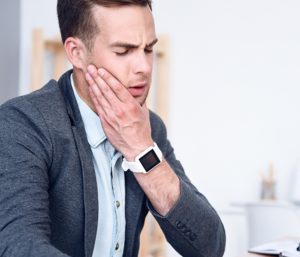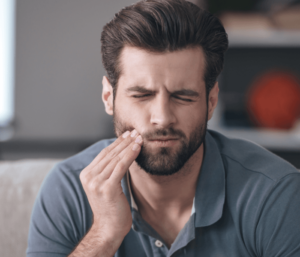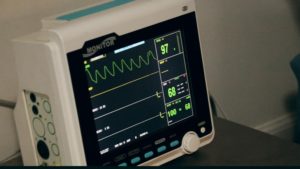OROFACIAL PAIN
July 11, 2022
 There are many people who suffer with pain involving some area of the head. Toothaches can cause pain, but these are mostly avoidable with proper diet, home care and regular visits to your dentist. Teeth can also play an indirect role in facial/head pain.
There are many people who suffer with pain involving some area of the head. Toothaches can cause pain, but these are mostly avoidable with proper diet, home care and regular visits to your dentist. Teeth can also play an indirect role in facial/head pain.
Orofacial pain includes a number of clinical problems involving the chewing (masticatory) muscles and/or temporomandibular joints (TMJs). Problems can include TMJ discomfort involving muscle spasms in the head, neck, shoulders and/or jaw, migraines or other types of tension headaches, pain with the teeth, face or jaw; and can even play a role in anxiety and/or depression.
You swallow approximately 2,000 times per day, which causes the upper and lower teeth to come together and push against the skull. People who have an unstable bite, missing teeth, or poorly aligned teeth can have trouble because the muscles work harder to bring the teeth together, causing strain. People with seemingly good teeth/bite are also susceptible. Pain can also be caused by clenching or grinding teeth, trauma to the head and neck, or poor ergonomics. Temporomandibular disorders (TMD) affect more than 10 million Americans. Your TMJ’s are located where the skull connects your lower jaw to the muscles on the sides of your head and face controlling the joint’s movements. Women between the ages of 20 and 40 are often more frequent sufferers because of the added estrogen in their bodies.
One in eight Americans suffers from headaches. Experts estimate that 80 percent of all headaches are caused by muscle tension, which may be related to the bite. Clenching the jaw muscles creates tension in the muscles that close the jaw, the main one of which is the temporalis muscle. Signs that may indicate a headache from dental origin include: pain behind the eyes, sore jaw muscles or “tired” muscles upon awaking, teeth grinding, clicking or popping of the jaw joints, head and/or scalp is painful to the touch, earaches or ringing, neck and/or shoulder pain, and dizziness. Keep in mind that in a 24-hour period of time, your teeth should only touch 10 minutes total. If you clench or grind your teeth, your teeth are touching much more than that and I can promise you that something in the masticatory system is being affected.
Sleep disorders can also play a role. I am not just talking about sleep apnea. There are a wide range of sleep disorders and some of them will cause people to clench and/or grind as a defense mechanism of the body to achieve proper air flow.
Dentists have a variety of ways to help relieve orofacial symptoms. One way to treat these problems is called an orthotic, or splint, that is worn over the teeth to help stabilize the bite; kind of like an orthotic some wear in their shoes for alignment and balance when standing. Permanent correction may require equilibration (reshaping teeth), prosthetic dentistry and/ or orthodontics. Many use a splint on a daily basis to avoid having these other treatments done.
Orofacial pain can range from tolerable to debilitating. Maintaining or correcting your bite ensures optimal health, and proper care will help reduce or eliminate orofacial pain or discomfort. If your dentist can not help you, ask for a referral.
Most important lesson of the day: The optimal rest position of the jaw (minus the 10 minutes the teeth touch in 24 hours) is lips together, teeth slightly apart, the tip of the tongue resting just behind your upper front teeth, and you should be breathing through your nose.
Dr. St. Clair maintains a private dental practice in Rowley and Newburyport dedicated to health-centered family dentistry. He has a special interest in treating snoring, sleep apnea and TMJ problems. If there are certain topics you would like to see written about or questions you have, please email them to him at jpstclair@stclairdmd.com
A BASEBALL LESSON
June 27, 2022
 Baseball season is in full “swing” this season with many kids playing throughout the summer. Here’s a lesson about why it’s important to protect your teeth no matter what you are playing.
Baseball season is in full “swing” this season with many kids playing throughout the summer. Here’s a lesson about why it’s important to protect your teeth no matter what you are playing.
In the spring of 1939, in celebration of the 100th year anniversary of baseball, catcher Joe Sprinz of the Pacific Coast League’s San Francisco Seals announced that he would attempt to establish the world record for catching a baseball dropped from the highest height ever — 800 feet. It would occur during a baseball game before a crowd of 15,000. Coincidently it was Sprinz’s 37th birthday too.
Five balls were to be dropped from the Goodyear blimp hovering overhead. Sprinz missed the first four balls. But on the fifth, the blimp’s captain, A. J. Sewell (an ace bomber pilot during World War I), said he “thought that Sprinz had it.” He added, “From the ship [blimp] it looked as if it hit his glove first. … He walked quite a ways and then sat down. Then some persons crowded around him and we saw him lying down.”
A University of California mathematician calculated the ball was traveling at 145 miles an hour when Sprinz made his catch. The force of the ball gathered as it descended from the blimp, tearing Sprinz’s hands apart, causing the ball to crash against his face. Sprinz had knocked out eight teeth, fractured his upper jaw, broke his nose, and severely lacerated both lips.
The following day, Sprinz “murmured” through his hospital bandages and a wired jaw reflecting on what happened: “I had the ball judged all the way. The ball hit my glove. … [It] didn’t hit my face. The jar of the ball drove the mitt back against my mouth and caused all the damage.”
“Most of the eight teeth lost were bridgework and can be replaced,” his doctor noted. Sprinz chimed in that he was more hurt and baffled by his failure to hold onto the ball “than he is hurt by his hurts.” He returned the following year in May 1940 as the starting catcher for the Seals, claiming he was “just as good” as he was before the accident.
After his retirement from baseball in 1942, he worked with the Seals back office and later with little leagues and the San Francisco Parks and Recreation Department, developing intercity baseball. Sprinz died in 1977 in San Francisco. He was 91.
Sprinz’s catch was officially recorded in the Guinness Book of World Records as the World’s Highest Catch in 1994.
In 2013, baseball sportswriter Zack Hample decided to break Sprinz’s record. He accomplished the feat in July 2013, catching a baseball dropped from a helicopter at 1,050 feet. Unlike Sprinz — and maybe because of him — Hample wore protective gear, including a catcher’s mask, hard-shell protective headgear, and breast plate. Nobody from the Guiness World Record organization attended, although invited. Hample lost no teeth. Officially, Sprinz still holds the record.
Lesson #1: Don’t’ try to catch a baseball dropped from any flying machine; it’s not worth it.
Lesson #2: Baseball is not considered a contact sport but there are many ways “contact” can be made with the mouth. Despite the fact that mouthguard protection is not the “in” thing to do when plying baseball, I highly recommend it.
Dr. St. Clair maintains a private dental practice in Rowley and Newburyport dedicated to health-centered family dentistry. He has a special interest in treating snoring, sleep apnea and TMJ problems. If there are certain topics you would like to see written about or questions you have, please email them to him at jpstclair@stclairdmd.com
INFO FOR NEW MOMS
June 20, 2022
The key to a child’s good dental health begins before his or her teeth become visible. Here are some answers to some of the most frequently asked dental health questions relating to pregnancy, infants, toddlers and children.
- Does being pregnant affect my oral health? Yes… hormonal changes exaggerate the way gum tissues react to the irritants in plaque. Thorough brushing and flossing of your teeth twice daily to remove the plaque and eating a balanced diet will help to keep your gums healthy.
- Should I visit my dentist during my pregnancy? Yes… you should continue regular dental visits. However, it is very important to let your dentist know that you are pregnant. You may be asked to be seen more frequently.
- Are x-rays safe during pregnancy? Yes… x-rays are safe during pregnancy and are a vital tool used in helping to detect dental and other oral health problems. Only the x-rays that are necessary for treatment will be taken. You will be asked to wear a lead apron for extra protection.
- 4. When will my infant begin to get teeth? Tooth eruption varies from infant to infant. However, most infants will start to get teeth around six to 12 months of age.
- When should I begin to brush my infant’s teeth? Starting at birth, clean your infant’s gums with a soft infant toothbrush, cotton gauze, or cloth and cool water. For infants under two years of age, parents should consult their child’s dentist before introducing a fluoride toothpaste.
- How much fluoridated toothpaste should I use when brushing my child’s teeth? Beginning at 2 years of age, a pea-sized amount of fluoridated toothpaste should be used during brushing. Children should be encouraged to spit, not swallow, toothpaste, and the amount of toothpaste used can be increased after five or six years of age when the child can reliably do this.
- When should I take my baby in for his/her first dental visit? This varies among practitioners. Consult your family dentist. In the meantime, look into the child’s mouth on a regular basis to make sure you don’t see anything unusual.
- How can I prevent my infant from getting early decay, know as early childhood caries or baby bottle tooth decay? When placing your infant down to sleep (nap or nighttime), place only water in the bottle. Sugary liquids like formula, breast milk, juice and soda can pool around the infant’s teeth and cause decay. Don’t forget to clean or brush your infant’s gums/teeth twice daily to remove food and plaque.
- What else can I do to keep my child’s teeth healthy? Children are not born with the bacteria that cause decay. They are exposed to these bacteria from their caregivers, especially their mothers. By keeping your teeth healthy and free from decay, you can help reduce your child’s exposure to these bacteria and reduce the chances of early decay.
- What can I do to help my baby through teething? Many babies like a teething ring, cool spoon, or cold wet washcloth. Some parents/care providers rub their infant’s gums with a clean finger.
Dr. St. Clair maintains a private dental practice in Rowley and Newburyport dedicated to health-centered family dentistry. He has a special interest in treating snoring, sleep apnea and TMJ problems. If there are certain topics you would like to see written about or questions you have, please email them to him at 
DENTAL EMERGENCY
June 13, 2022
 In a recent study published by the American Dental Association (ADA), visits to the emergency room (ER) for dental related issues have doubled nationwide over the last decade. Last year, over 2.1 million people visited the ER for a dental “emergency”, most of which could have been prevented with regular dental visits.
In a recent study published by the American Dental Association (ADA), visits to the emergency room (ER) for dental related issues have doubled nationwide over the last decade. Last year, over 2.1 million people visited the ER for a dental “emergency”, most of which could have been prevented with regular dental visits.
In another recent collaborative study between the Rutgers School of Dental Medicine and the Rutgers Center for State Health Policy, they confirmed that most of these ER visits were for dental pain and infections that were not related to trauma. This is an increasing burden on the taxpayer and the healthcare system. ER visits can be 10 times more costly than if the treatment was performed in a dental office.
Dr. Cecile Feldman, dean of the Rutgers School of Dental Medicine, recently said the following in an ADA publication:
“The most disturbing aspect of the rise in ER dental visits is that treatment is often ineffective. In emergency rooms, there is a lack of diagnostic equipment and tools – such as dental X-ray machines – and ER physicians aren’t trained to identify and treat oral health problems. Often, they prescribe painkillers and antibiotics for infections while the underlying problem remains.”
The increase in dental ER visits supports the fact that many Americans have inadequate knowledge about the consequences of not getting regular dental check-ups. Many view dental care as a luxury and if their teeth don’t hurt and appear visually acceptable, they do not feel the need to visit a dentist.
Dental decay is the underlying cause of most ER dental visits. Dental decay does not hurt until it has affected the nerve of the tooth. Dr. Feldman states, “Tooth decay, which is almost entirely preventable, is the most common chronic illness among school-age children. Left untreated, it can result in infection, unbearable pain, loss of teeth and acute systemic infection, which in some cases can lead to death. Yet nearly one in four American children has untreated tooth decay.”
So, what are some of the underlying reasons for the increase in ER visits? Dr. Feldman says, “For many, a visit to the dentist is unaffordable and inaccessible. More than 85 million Americans have no form of dental insurance. For those who have Medicaid, finding a dentist who accepts it can be challenging. Many dentists don’t because the reimbursement payments are a fraction of the cost of care and there is a very high administrative burden.”
I have seen many suggestions for helping address this problem. Some push for more community water fluoridation, others for dental coverage for all. While children do have coverage under some medical insurance plans, it does not extend to adults. I’m not so sure that is the answer anyway, mainly due to the cost.
Dental insurance, in general, is a broken system. Unless there is some major overhaul in the way dental care or dental insurance is delivered in this country, the ER stats will continue to rise. For now, personal responsibility and budgeting for basic preventive dental care is your best defense against future dental problems.
Dr. St. Clair maintains a private dental practice in Rowley and Newburyport dedicated to health-centered family dentistry. He has a special interest in treating snoring, sleep apnea and TMJ problems. If there are certain topics you would like to see written about or questions you have, please email them to him at jpstclair@stclairdmd.com
SWEET TOOTH
June 6, 2022
 Dental caries (cavities, decay) is still very prevalent in today’s society. There are many factors that contribute to dental decay. In addition, there are some people who are more susceptible to decay than others. In a recent article in the Journal of the American Dental Association (JADA), sugar-sweetened beverages, one of the main culprits for dental decay, was discussed.
Dental caries (cavities, decay) is still very prevalent in today’s society. There are many factors that contribute to dental decay. In addition, there are some people who are more susceptible to decay than others. In a recent article in the Journal of the American Dental Association (JADA), sugar-sweetened beverages, one of the main culprits for dental decay, was discussed.
Dental decay is a multifactorial disease characterized as an infectious process during which carbohydrates are fermented by specific oral bacteria at the tooth surface. This results in acid production and enamel breakdown. It should be noted that the beverages described in this column are not the only things that lead to dental decay. Anything rich in carbohydrates or with high acidity can lead to decay. In addition, the right bacteria, genetics, insufficient home care, and salivary flow are all contributing factors.
With regard to beverages specifically, as described in the JADA article, the main carbohydrate additives to note are sugar, lactose, high-fructose corn syrup, sucrose, fructose, glucose, maltodextrin, and honey. The beverages to watch for containing these are milk – yes milk, flavored milk, 100 percent fruit juice and vegetable juice, soda, juice drinks, sports drinks, flavored water, flavored tea and coffee, energy drinks, smoothies, and nutritional supplements.
People usually consume multiple beverages daily. As I have described in past columns, one of the worst things you can do is to drink these kinds of beverages slowly throughout the day. Constant introduction of carbohydrates over a prolonged period feed bacteria and never allow the saliva to neutralize the oral environment. If you have decreased salivary production, this makes the situation much worse.
Here is a list of recommendations as stated in the JADA article:
- Consume these types of beverages at meals only
- Limit these types of beverages to once per day and to 12 ounces
- Consume these beverages within a 15-minute time frame
- Using a straw is preferable
- Replace these sugary beverages with artificially sweetened or unsweetened beverages. ** I would add to that preferably non-carbonated
- Brush teeth with fluoridated toothpaste 20 minutes after intake
- Chew sugar free gum immediately after intake
- Rinse mouth with water immediately after intake
Dental decay is preventable. Following the guidelines above, and practicing good oral hygiene can prevent the most common reasons for decay. It is important to note that most people have plenty of room for improvement with their oral hygiene. Brush your teeth right before your next dental appointment and then ask your hygienist or dentist to assess how well you are doing at plaque removal. You may be surprised at what you’re missing.
Dr. St. Clair maintains a private dental practice in Rowley and Newburyport dedicated to health-centered family dentistry. He has a special interest in treating snoring, sleep apnea and TMJ problems. If there are certain topics you would like to see written about or questions you have, please email them to him at jpstclair@stclairdmd.com
IT’S A CHOICE – PART 2
May 31, 2022
 Last week I introduced a couple who had been seeing the same dentist for 30 years and were finally forced to make a change due to the dentist’s retirement. They visited a “new” dentist and were turned off because the dentist recommended significant treatment. Then they consulted with another dentist, who spent more time with them to discuss their specific situations and goals. However, they still missed their “old” dentist.
Last week I introduced a couple who had been seeing the same dentist for 30 years and were finally forced to make a change due to the dentist’s retirement. They visited a “new” dentist and were turned off because the dentist recommended significant treatment. Then they consulted with another dentist, who spent more time with them to discuss their specific situations and goals. However, they still missed their “old” dentist.
The couple loved their “old” dentist because she was someone they could relate to. The dentist kept things simple, and they liked simple. If they had a broken tooth, the dentist patched it up and they were on their way. They never talked about the future. They may have lost some teeth over the years, but the dentist never discussed “needing” a lot of dental work.
The first “new” dentist was a nice person. In fact, they knew the dentist outside the office before they became patients. The problem was poor communication and inability to relate to the patient’s specific needs. This dentist looked in both their mouths and said they each “needed’ 8 crowns. It didn’t make sense to them. It seemed too complicated, expensive and unnecessary.
The second “new” dentist took a different approach and spent time with the couple discussing their current situation and future objectives. They both wanted to keep their teeth but still had trouble coming to grips with the fact that they “needed” significant dental work to accomplish their objective. Why couldn’t they continue on the same simple path they had with their original dentist?
Dentists are sometimes more interested in what they are saying than patients are. It is important to remember that the teeth are attached to a person; and that person has their own story that goes along with their teeth.
People put different values on different things. Whether we sell cars, trips, hairstyles or teeth, the objective of the “seller” is to make the prospective “buyer” aware of what they have and all the possibilities that are available to them. It is always the consumer’s decision. While there is a health component to dentistry, you can compare any other aspect of selling the other commodity examples to teeth. Things that come to mind: comfort, looks, self-esteem, and functioning in life.
To “buy” anything, people have to be ready. What makes someone ready? They are ready when they feel the need to act. In the absence of readiness, over-education by the “seller” often feels like sales pressure to the buyer. I’m sure you have experienced this if you have ever been to a car dealership.
I love analogies. I especially love car analogies as they relate to dentistry. Cars are easy because most of us rely on them every day, just like our teeth. Some of us like simple cars, while others like fancier cars. Some take better care of their cars and they last longer. Others abuse their cars and they need more repairs. One thing is certain; maintenance is the key to long-term success of the car.
Raising awareness is a difficult task for anyone promoting their product or service. Acting on something is only accomplished when value is realized. Some end up seeing the value in their life and others do not.
Dr. St. Clair maintains a private dental practice in Rowley and Newburyport dedicated to health-centered family dentistry. He has a special interest in treating snoring, sleep apnea and TMJ problems. If there are certain topics you would like to see written about or questions you have, please email them to him at jpstclair@stclairdmd.com
IT’S A CHOICE – PART 1
May 23, 2022
 People often ask me how I have time to write columns, and how I’ve come up with topics for as long as The Town Common has been around. If you have read my columns over the years, you’ll remember I have discussed that time was one of the barriers keeping people from getting the dental care they need. Time is an excuse and I use it as an excuse all the time. However, we always make time for things that are important to us.
People often ask me how I have time to write columns, and how I’ve come up with topics for as long as The Town Common has been around. If you have read my columns over the years, you’ll remember I have discussed that time was one of the barriers keeping people from getting the dental care they need. Time is an excuse and I use it as an excuse all the time. However, we always make time for things that are important to us.
The topics I come up with have been an evolution. I try to keep it interesting. Of course, many of the things that I find interesting in dentistry would bore others. While some of my columns may bore you to tears, hopefully there are others that you can relate to, or stimulate thoughts or questions.
Let’s talk today about a common scenario seen in all dental offices. New patients, husband and wife in their 60’s, are “forced” to make a dental provider change. I say “forced” because regardless of our situation, we always have a choice in our providers.
This couple had been seeing the same dentist for 30 years. Despite the fact that they moved 20 miles from the dentist 10 years ago, they continued to make the drive to the office. They were dedicated and they loved their dentist. Then one day the dentist retired and they decided it was time to choose someone closer to where they lived.
Both went to their new office for hygiene appointments and then discussed their experience. They both felt the office staff was less friendly than their previous office. Of course, they knew that “old” office and loved everyone there. They were still willing to give it a chance, until they met the dentist. The dentist seemed like a nice person but took a quick look and said the same thing to both husband and wife – You NEED 8 crowns.
How could this be, they thought? They had been going to the same office for 30 years, neither ever had a crown, and when something broke, their favorite dentist would “patch” them up. They were completely turned off. They were “forced” again to make a change.
This time they wanted to meet the dentist first and see what the dentist had to say before they committed. They set up a 30-minute appointment. At that appointment, the “new” dentist examined their x-rays and took photographs of their teeth. They had an in-depth conversation about the condition of their dental health. They were asked what their short-term and long-term objectives were. The word “crown” was never mentioned…..until one of them asked the dentist.
The dentist discussed advantages and disadvantages of different kinds of treatment. Since the patient’s long-term objective was to have teeth forever, they discussed options for treatment, prioritization and sequencing, as well as financial options. Although they were not ready to dive into treatment, they left the office with a much better understanding of where they stood and appreciated the time that was taken to explain their specific situations.
Every person, every patient, every dentist, is different. This couple experienced three different practice styles. They could relate to Dentist #1 – their “old” dentist. Dentist #2 lacked communication skills, therefore the relationship failed. Dentist #3 took the time to learn about their specific needs and goals. They didn’t feel sales pressure but are still overwhelmed by their apparent “needs.”
To be continued……
Dr. St. Clair maintains a private dental practice in Rowley and Newburyport dedicated to health-centered family dentistry. He has a special interest in treating snoring, sleep apnea and TMJ problems. If there are certain topics you would like to see written about or questions you have, please email them to him at jpstclair@stclairdmd.com
INFORMATION FOR CARDIAC PATIENTS
May 16, 2022
 It is common sense that infected teeth, whether they hurt or not, or are broken down beyond repair, should be removed. We also all know by now that there are mouth-body connections and that the mouth is the “gateway” to the rest of the body. There is no disputing that a healthy mouth is better for you on many levels. However, in a recently released study, the guidelines for treatment of some types of dental problems prior to specific surgery need closer consideration.
It is common sense that infected teeth, whether they hurt or not, or are broken down beyond repair, should be removed. We also all know by now that there are mouth-body connections and that the mouth is the “gateway” to the rest of the body. There is no disputing that a healthy mouth is better for you on many levels. However, in a recently released study, the guidelines for treatment of some types of dental problems prior to specific surgery need closer consideration.
According to a study in an issue of The Annals of Thoracic Surgery, removing an infected tooth prior to cardiac surgery may increase the risk of major adverse outcomes, including risk of death prior to surgery. This is a very specific study for a very specific group of patients. It does suggest considering postponing dental problems prior to any surgery.
Dental extraction of abscessed or infected teeth is often performed to decrease the risk of infection during surgery and endocarditis (an inflammation of the inner layer of the heart) following surgery. In this particular study, physician researchers evaluated the occurrence of major adverse outcomes in 205 patients who underwent at least one dental extraction prior to planned cardiac surgery. The median time from dental extraction to cardiac surgery was 7 days (average 35 days).
One of the researchers explained, “Guidelines from the American College of Cardiology and American Heart Association label dental extraction as a minor procedure, with the risk of death or non-fatal heart attack estimated to be less than 1%. Our results, however, documented a higher rate of major adverse outcomes, suggesting physicians should evaluate individualized risk of anesthesia and surgery in this patient population.”
In this study, patients who underwent dental extraction prior to cardiac surgery experienced an 8% incidence of major adverse outcomes, including new heart attack, stroke, kidney failure and death. Overall, 3% of patients died after dental extraction and before the planned cardiac surgery could be performed. Another of the researchers went on to say, “With the information from our study we cannot make a definitive recommendation for or against dental extraction prior to cardiac surgery. We recommend an individualized analysis of the expected benefit of dental extraction prior to surgery weighed against the risk of morbidity and mortality as observed in our study.”
This study, as in many “new” studies, awakens us to consider a departure from current lines of thinking about specific situations. This paradigm shift of thinking has also been noted in the use of prophylactic antibiotics prior to dental procedures in those with cardiac conditions.
Prophylactic antibiotics have routinely been prescribed for patients undergoing dental work who also had existing heart problems because it had been accepted that there is a link between dental bacteremia and endocarditis. Individuals with pre-existing heart problems tend to have a higher incidence of endocarditis. The American Heart Association and others have withdrawn support for this practice of prophylactic antibiotics because the danger from overuse of antibiotics outweighs any other potential risks. Regular tooth brushing, flossing, and even chewing gum are now recognized to dislodge as much, if not more, bacteremia than most dental procedures.
Prevention of dental problems is the best line of defense. Regular professional maintenance, especially as we age, is important to our overall health. Talk with your dentist and physician about your specific situations.
Dr. St. Clair maintains a private dental practice in Rowley and Newburyport dedicated to health-centered family dentistry. He has a special interest in treating snoring, sleep apnea and TMJ problems. If there are certain topics you would like to see written about or questions you have, please email them to him at jpstclair@stclairdmd.com
COMMUNICATION IS KEY
May 9, 2022
 It is not uncommon to get a second opinion, or a second or third quote for things like car repairs and home improvements. When it comes to our health, it usually depends on the nature of the issue. More complex issues in medicine, such as a diagnosis of cancer, an unknown diagnosis, or other major medical issues in which we have to make decisions about significant treatment, tend to stimulate people to get more than one opinion. In dentistry, it seems that the incidence of second opinions is not as great.
It is not uncommon to get a second opinion, or a second or third quote for things like car repairs and home improvements. When it comes to our health, it usually depends on the nature of the issue. More complex issues in medicine, such as a diagnosis of cancer, an unknown diagnosis, or other major medical issues in which we have to make decisions about significant treatment, tend to stimulate people to get more than one opinion. In dentistry, it seems that the incidence of second opinions is not as great.
Routine dental care is generally not that complicated. There are many different ways to do the simplest things in dentistry. The method is a function of the dentist’s beliefs and training. It is relatively uncommon for a patient to get a second opinion for this type of maintenance dental care. Although there is some subjectivity as to what different dentists might deem as “needing” to be done, patients usually base their decision on their perceived need. This perception of need comes from the dentist’s ability to communicate the reasons for treatment.
The patient’s trust in their provider is a big factor. If a patient trusts and genuinely likes their dentist, they may not necessarily do or want to do what the dentist wants them to, but they are comfortable enough to make the decision on treatment. It is when there is a lack of trust, for one reason or another, that patients tend to venture out for another opinion. This lack of trust usually stems from a personality conflict or the inability of the dentist to properly communicate with the patient effectively.
Even when there are more complex dental issues, it is my feeling that patients base the need for another opinion on lack of trust. Another important factor is that the patient is given choices. Patients always have the right to choose what treatment they feel is right for themselves. If choices are given and the treatment is properly communicated to the patient, they have the ability to decide in what direction to proceed.
If a dentist properly communicates the need for treatment and the patient decides to do nothing, it is the patient’s choice. It is when treatment is properly presented and it aligns with the patient’s perception of need or desire, that the patient moves forward with treatment.
Fees tend to be a less common reason for patients to seek another opinion. Fees for treatment can definitely vary. The problem with seeking treatment based on fees is that the same treatment in two different offices with different fees can also vary in the level of expertise and precision in which it is done. There are many factors.
A higher fee does not always mean a higher quality product. Fees are generally based on the time involved, the materials used, and the perceived expertise of the provider. Be cautious when seeking treatment based on fees. The fee for treatment should definitely be considered, but the entire treatment presentation and the way in which it is communicated should be used to determine your decision.
Dr. St. Clair maintains a private dental practice in Rowley and Newburyport dedicated to health-centered family dentistry. He has a special interest in treating snoring, sleep apnea and TMJ problems. If there are certain topics you would like to see written about or questions you have, please email them to him at jpstclair@stclairdmd.com
PROTECT YOUR TEETH!
May 2, 2022
 This past weekend, my brother sent me a text with a picture of my 15-year-old nephew all bloodied-up with broken upper and lower teeth. He is a mountain bike daredevil…..and the mountain won the battle. Protection of for the teeth is not just for certain sports.
This past weekend, my brother sent me a text with a picture of my 15-year-old nephew all bloodied-up with broken upper and lower teeth. He is a mountain bike daredevil…..and the mountain won the battle. Protection of for the teeth is not just for certain sports.
Mouthguards are nothing new, but there are still far too many sports related injuries. Although most youth sport organizations have cracked down on making kids wear mouth protection, there are still injuries occurring. Taking the appropriate protective measures while on the court, field, rink, or ring can save mouths from serious injury and costly dental repairs.
Any sport that presents the chance of contact or collision with another person, object, or surface can potentially cause injury to teeth, jaws, and oral soft tissue. These sports include, but are not limited to, football, basketball, soccer, hockey, boxing, and lacrosse. Individuals who participate in sports, such as biking, inline skating, or skateboarding are also at risk for injury.
Teeth get in the way. Other than your nose, front teeth are “out there” and your lips only provide minimal protection. For example, a student I saw this past spring was injured playing squash at a local private school. Squash is a non-contact sport, but the game is played in close proximity to another player with a swinging racquet. The student I treated had been hit in the mouth with the other player’s racquet. He required a root canal on one front tooth with a crown. The other front tooth needed to be extracted and replaced with a dental implant. All of this could have been prevented or at least damage lessened with the use of a mouthguard.
For some reason, baseball is one of those sports where kids do not wear protective mouthguards. No matter what age level, a player can misjudge a ball or a ball can take an unexpected bounce, causing serious injury.
In lacrosse, both boys and girls should always be wearing mouth protection. That ball is extremely hard and heavy. Boys are better protected than girls because they at least wear helmets; both should be wearing helmets, in my opinion.
A custom mouthguard made by your dentist covers the upper teeth with a soft, flexible material that prevents serious injuries such as broken teeth, jaw fractures, cerebral hemorrhage, and neck injuries. It decreases the chance of the lower jaw jamming into the upper jaw or being pushed back into the temporomandibular joint (TMJ). Mouthguards may reduce the severity and incidence of concussions as well.
Custom mouthguards, made by a dentist, fit 100 times better than anything you can buy in a store. This not only improves performance (making it easier to breathe), but also makes it more likely the athlete will keep the mouthguard in. They may cost more than the boil/bite generic ones, but they are better, and that is enough reason to consider them.
If you seek treatment immediately after the injury occurs, your dentist often can save knocked-out teeth and repair minor chips and cracks with appropriate dental materials. See your dentist for evaluation if your tooth changes color, if you experience any pain, or if you notice any swelling in or around your mouth following trauma.
Even if it isn’t “cool” to wear a mouthguard in the sport you are playing, I strongly recommend it. You only get one set of your own teeth.
Dr. St. Clair maintains a private dental practice in Rowley and Newburyport dedicated to health-centered family dentistry. He has a special interest in treating snoring, sleep apnea and TMJ problems. If there are certain topics you would like to see written about or questions you have, please email them to him at jpstclair@stclairdmd.com







